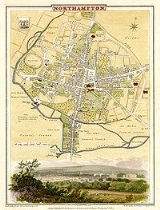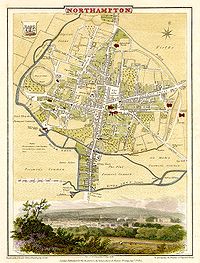
Northampton's tunnels
Encyclopedia

Northampton
Northampton is a large market town and local government district in the East Midlands region of England. Situated about north-west of London and around south-east of Birmingham, Northampton lies on the River Nene and is the county town of Northamptonshire. The demonym of Northampton is...
is a large market town
Market town
Market town or market right is a legal term, originating in the medieval period, for a European settlement that has the right to host markets, distinguishing it from a village and city...
and a local government district
Non-metropolitan district
Non-metropolitan districts, or colloquially shire districts, are a type of local government district in England. As created, they are sub-divisions of non-metropolitan counties in a so-called "two-tier" arrangement...
in central England
England
England is a country that is part of the United Kingdom. It shares land borders with Scotland to the north and Wales to the west; the Irish Sea is to the north west, the Celtic Sea to the south west, with the North Sea to the east and the English Channel to the south separating it from continental...
upon the River Nene
River Nene
The River Nene is a river in the east of England that rises from three sources in the county of Northamptonshire. The tidal river forms the border between Cambridgeshire and Norfolk for about . It is the tenth longest river in the United Kingdom, and is navigable for from Northampton to The...
, and the county town
County town
A county town is a county's administrative centre in the United Kingdom or Ireland. County towns are usually the location of administrative or judicial functions, or established over time as the de facto main town of a county. The concept of a county town eventually became detached from its...
of Northamptonshire
Northamptonshire
Northamptonshire is a landlocked county in the English East Midlands, with a population of 629,676 as at the 2001 census. It has boundaries with the ceremonial counties of Warwickshire to the west, Leicestershire and Rutland to the north, Cambridgeshire to the east, Bedfordshire to the south-east,...
; its history goes back many centuries with much of the present town's development taking place during medieval times.
Underground
Today underneath the modern streets there still remains a labyrinth of tunnels, along with many cellars and ancient crypts. Many of these cellars are thought to have originated from the church buildings, that today are centred around All Saints Church - for instance underneath the Northampton & County Club in George Row (opposite the church) can be seen some fine vaulted cellars.Similar tunnels can be seen on the other side of the church at Drum Lane - underneath the Shipmans public house. John Speed
John Speed
John Speed was an English historian and cartographer.-Life:He was born at Farndon, Cheshire, and went into his father's tailoring business where he worked until he was about 50...
's map of Northampton from 1610 show that the church was then the largest landowner in the town.
Clashes took place over the years between the church and the monarchy - such as the banning of markets being held in the churchyards. It is thought that various of these tunnels were established as some sort of escape routes for the clergy for use in times of trouble. The various religious houses in early times were found at all the main 8 compass points - giving rise to a series of radial tunnels heading out from All Saints Church at the centre of town to the various houses.
Some tunnels had a more mundane function - channelling water from the springs on what is now the Racecourse and Springfield into the town centre. These conduits were known respectively as the Great and the Little Conduits.
Northampton Castle was once one of the most important in the country and there is a suggestion that at least one tunnel linked the castle to All Saints Church - and even that such a tunnel might have been utilised by Thomas a Becket in his escape from the castle and the town on his way to France.

It is also thought that a tunnel may have allowed the nuns of Delapré Abbey
Delapré Abbey
Delapré Abbey , or more properly, the Convent of St Mary De La Pré, was founded as a Cluniac nunnery about the year 1145, situated in the meadows of the River Nene to the south of Northampton ....
, on the outskirts of the town to escape the Battle of Northampton
Battle of Northampton (1460)
The Battle of Northampton was a battle in the Wars of the Roses, which took place on 10 July 1460.-Background:The Yorkist cause seemed finished after the previous disaster at Ludford Bridge...
- which raged in their grounds. It is thought that this tunnel ran via All Hallows Church (now known as St Johns) at the bottom of Bridge Street.

